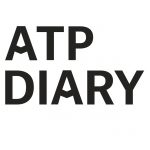ENG-ITA
THE GOOGLE TRILOGY | Report a Problem • Michele’s Story • The Driver and the Cameras
THE GOOGLE TRILOGY – 3.The Driver and the Cameras, 2012. Sublimation print on aluminum. 11 elements. Diameter of each photo: 20cm
Each Google Street View car is equipped with a Dodeca 2360 camera with eleven lenses, capable of photographing 360 degrees. Afterwards the photos are assembled, creating a stereoscopic view, and an algorithm developed by Google automatically blurs the faces of people to protect the privacy of those accidentally portrayed. To create this series of photographs, I went looking for faces that had escaped Google Street View’s algorithm. The eleven portraits I isolated immortalize the driver of the Google car. The driver is a sort of phantom power; he appears where he shouldn’t be and his presence has escaped censure. His face is the symbol of an error yet at the same time shows a human side and, perhaps, the limits of technological power.
VIEW OF THE INSTALLATION AT THE PHOTOGRAPHERS’ GALLERY
EXHIBITIONS
- (2021) (Solo Exhibition) Modern Art Base. rs548049170_1_69869_TT (The Other Shapes of Me): Errors, Limits and Malfunctions, curated by Ramdom and ArtHub Asia, Shanghai, China
- (2020) Ricalcolo. Di territori computanti e dei loro attuatori analogici. Curated by Davide Bevilacqua, Gorizia, Italy
- (2018) The Photographers’ Gallery. All I Know is What’s on the Internet, curated by Katrina Sluis, Karen McQuaid and Sam Mercer, London, UK.
- (2015) #watch22, curated by Günter Minas, Bonifazius-Türme, Mainz, Germany
- (2015) Luoghi Comuni Festival – Net Art Section, Altamura (BA), Italy
- (2014) EMAF 27th European Media Arts Festival, WE. THE ENEMY, Kunsthalle Osnabrueck, Germany
- (2014) SLINGSHOT, Festival of Music, Eletronic Art & Technology, Athens GA, US
- (2013) Jarach Gallery, Echo Back. Figure di Interferenza, curated by Stefano Coletto, Venice, Italy
- (2013) INTERNET&TACOS, curated by INTERNET&TACOS, space for digital culture and Internet politics, Hildesheim, Germany
- (2013) Museum of Contemporary Art Vojvodina, Autonomies, curated by NAPON (Institute for flexible cultures and technologies), Novi Sad, Serbia
- (2013) COLLISION19, COmpress/DECompress, guest curated by Stephanie Dvareckas, works selected by: William Tremblay, Georgina Lewis, Mark J. Stock, Rob Gonsalves and Stephanie Dvareckas, Boston Cyberarts Gallery, USA
SOME PERSONAL THOUGHTS ON GOOGLE MAPPING:
A layer of subtle threads connects digital cartographic techniques, map users, and mapping technologies. To each kind of map, corresponds a certain set of ideals, which informs the work of the map makers, and in turn produces specific subjectivities that operate in relation to specific mapping technologies. In other words, by looking at today’s digital mapping, we can discern a set of particular ideologies that guide how maps are imagined, coded, designed and used, and how they operate across physical and virtual realities. More importantly, by looking at digital mapping, we can retrace how particular ideological constructions are mediated and conveyed by specific digital artifacts, and how the interweaving of these conceptual and technical threads informs the fabric of our very subjectivity.
Google’s mapping project is the perfect exemplification: it consists of a layered entity revolving around two main poles: Google Maps, with its emphasis on routing and navigation, and Google Earth, with its emphasis on geo-visual exploration. When considered in its entirety, the assemblage of Google services, platforms, infrastructures, applications and technologies presents the world as a seamlessly searchable, movable and navigable representation. Technical descriptions of how Google mapping is configured (in terms of hardware, software, services and applications) can easily become outdated because of the company’s constant updates. Nevertheless, what began as a series of mapping experiments in 2007 has grown to offer navigable photo-panoramas in 3D and cartographic maps in 2D through Google Maps and Google Street View, 3D navigable aerial and satellite views through Google Earth, along with the celestial representations of Google Sky – ultimately configuring Google mapping as the most used and widespread mapping technology in the world. Google mapping is predicated on ‘curating’ and ‘mobilitating’ content. Its mission is built upon a constant movement, the foundation for any form of mapping and exploration, here defined in the form of the digital movement of its users and their data, and in that of the geopolitical movements of the company itself at a global level.
The end-goal of Google mapping is nothing more than the oldest archetypical obsession of any mapping effort: that of mapping a territory until the map itself becomes a territory in its own right. In a way, it seems as if Google’s users can finally experience the map imagined in 1946 by Argentine writer Jorge Luis Borges in his On Exactitude in Science: a tale in which the Empire orders its cartographers to build a map so detailed that it ends up covering, and swallowing, the entire territory that it ought to represent.
And yet, digital mapping is inseparable from a subject always mediating his/her position and escaping fixity, in a process of spatial and visual mediation that I call media-flânerie. Historically, the word ‘flâneur’ gained cultural prominence in the 19th century, initially referring to people who loved to stroll and wander aimlessly. The flâneur was the first real connoisseur of the modern metropolis, and flânerie, from a cultural perspective, was the product of modern crowds, modern cities like Paris, and mass communication. But does it still make sense to talk of flânerie at a time in which people seem to be more and more confined by their technological devices? And what kind of flânerie is possible when public spaces of aggregation become increasingly rarer and leisure walks have almost disappeared under the freneticism of western lifestyles? As modern cities radically change and become increasingly more networked, the concept of media-flânerie can reflect the specificity of a media saturated environment. For example, whereas flânerie existed in relation to moving through the specific architecture of Paris’ arcades, media-flânerie is instead the product of new digital movements through software architectures, information highways, data aggregates, and hybrid interfaces. To each new set of movements and to each new kind of environment correspond new possibilities of media-flânerie. The media-flâneur, then, is the subject emerging from this particular intertwining of the politic with the poetic across new technologies of order and control, such as digital mapping, and through novel creative subversions of those very technologies. The suffix ‘media-’ stands for the important role played by multimedia technologies, but also, and more importantly, for issues of ‘mediation’ between predefined outputs and alternative goals that are at the core of creative exploitations of errors and glitches.
The flâneur, as it was first described by French poet Charles Baudelaire, and was later rethought by German philosopher Walter Benjamin, is also the subject who more than any other has represented and embodied scopic movement, eventually becoming the archetype of the modern observer. Today, what we consider the realm of visuality is constantly processed and dislocated via media technologies within an environment understood in itself as media-process. Can we still think of the Benjaminian flâneur as the subject at the center of such a media-environment? Today’s flâneur is concerned with urban spaces just as much as it is concerned with constant streams of images offered by all kinds of unified interfaces, digital tools and ubiquitous screens – with his or her movements constantly shifting between physical and virtual places. The media-flâneur operates in the interstices between data collection, social media presence, and 24/7 surveillance, where almost everything is always ready to be quantified and assembled into some kind of big-data pool. The media-flâneur spans mass participation, swarming, hyper-connectivity, collective intelligence, alienation, disjunction, paranoia and individualism – often in quick succession. Yet, the media-flâneur is also characterized by an appreciation of gaps, errors, ruptures and instabilities, as if he/she could find in them a way of escaping the capturing devices of media-capitalistic assemblages in which he/she is always already participating.
THE GOOGLE TRILOGY sits precisely within this fragmented landscape of images, maps, media processes, and cultural reconfigurations – presenting, representing and expanding the concept of a media-flânerie in constant becoming.
(SELECTED) BIBLIOGRAPHY

[INTERVIEW]
Doppiozero
“Glitch: la verità nell’errore. Conversazione con Emilio Vavarella”
Interview by Mauro Zanchi and Sara Benaglia, 5 July 2020. (ita)

[CRITICAL TEXT]
EAI Endorsed Transactions on Creative Technologies (European Union Digital Library)
Costa, F: “To be or not to be – a data set. Art, technology and identity in the new informational order”
vol. 7, Issue 22, pp. 1638-48. (eng)
[PDF]

[INTERVIEW]
Exibart
“Digitale Off Limits: intervista a Emilio Vavarella”
Interview by Maria Chiara Wang, July 2020. (ita)

[INTERVIEW]
Juliet
“Emilio Vavarella – Interdisciplinarità artistica”
Interview by Emanuela Zanon, Magazine n. 192, apr/mag 2019. (ita)

[EXHIBITION REVIEW]
Afterimage: The Journal of Media Arts and Cultural Criticism
“Exhibition Review: All I Know Is What’s On The Internet”
by Harriet Riches, vol. 46 no. 1, March 2019, pp. 47-52. (eng)
[SOURCE]

[EXHIBITION REVIEW]
Frieze
“What Role Do Photographers Play in an Increasingly Automated Image Culture?”
by Hettie Judah. 2018 (eng)

[EXHIBITION REVIEW]
WIRED (UK Edition)
“These photos capture the invisible workers of the internet”
by Thomas McMullan, 2018 (eng)

[PROJECT REVIEW]
Popula
“The Faces of Google Street View”
by Sophie Haigney, 2019. (eng)

[EXHIBITION REVIEW]
The New Scientist
“All I Know is What’s on the Internet review: The shocks don’t work”
print edition, by Lydia Nicholas, 2019 (eng)

[BA Thesis]
Leeds Art University – BA Photography
“What Can Machine Readable Photography Teach Us About Artificial Intelligence?”
by Thomas Griffiths, Advisor: Philip Welding, Leeds, UK, 2018/19. (eng)

[BOOK CHAPTER]
Error, Ambiguity, Creativity: A Multidisciplinary Reader
Vavarella, Emilio. “On Counter-Mapping and Media-Flânerie: Artistic Strategies in the Age of Google Earth, Google Maps and Google Street View”
Book edited by Sita Popat and Sarah Whatley, Palgrave Macmillan, 2020 (eng).
[BOOK]

[CONTRIBUTION]
Photomediations Machine
“The Google Trilogy”
Press coverage,
2013. (eng)
[PDF | SOURCE | PROJECT]

[PROJECT REVIEW]
Amusement
“The Google Trilogy, une Esthétique de l’Erreur Dèvoilée par Emilio Vavarella”
2013. (fra)

[PRESS COVERAGE]
MASHABLE
“Evocative Artists Inspired by Google Street View”
2014. (eng)

[WRITTEN CONTRIBUTION]
That’s IT! On the newest generation of artists in Italy and one meter eighty from the border
Vavarella, Emilio. “THE GOOGLE TRILOGY – COMPENDIUM: Or on the Rise of the Media-Flâneur”
Catalogue of exhibition at MAMbo – Museo di Arte Moderna di Bologna, 2018 (ita-eng).

[EXHIBITION CATALOGUE]
Compress Decompress
“The Driver and the Cameras”
Exhibition catalogue, 2013. (eng)
[PDF]

[PRESS COVERAGE]
Triplex Radio Canada
“Emilio Vavarella : quand les erreurs de Google deviennent de l’art”
2013. (fra)

[INTERVIEW]
Loosenart
“Glitch: The Truth in the Error. A Conversation with Emilio Vavarella”
by Sara Benaglia and Mauro Zanchi, August 2020. (eng)
[SOURCE (eng) | ARCHIVED]

[INTERVIEW / BOOK]
Metafotografia, Vol.2. Le mutazioni delle immagini
“Intervista 25: Emilio Vavarella”
Edited by Mauro Zanchi and Sara Benaglia (eds.) Skinnerbox, Jesi (Italy), 2020, pp. 112-117. (ita-eng).

[ACADEMIC PAPER]
Représentations, Mapping Mobility – Cartographies en mouvement
“Google Street View: Digital Mapping, Glitching and Social Documentary”
by Lisa FitzGerald, Université Grenoble Alpes, July 2019, pp. 95-107. (fre)

[ACADEMIC PAPER]
Politics of the Machines: Art / Conflict – Proceedings of POM Beirut 2019
“The deception of an infinite view – exploring machine vision in digital art”
by Linda Kronman 2019, PP. 70-77. (eng)

[ACADEMIC PAPER]
AusArt Journal for Research in Art
“Cómo desaparecer del mapa: un caso práctico de disidencia online”
by Sergio Luna and Yasmina Morán Conesa, vol.6, n.2, 2018, pp.9-21. (spa)

[PhD Dissertation]
Internet Explorer: The Creative Administration of Digital Geography
PhD dissertation by Sheridan Coleman
School of Humanities, Department of Art, Curtin University, 2017. (eng)

[ACADEMIC PAPER]
rsf rivista di studi di fotografia
“Earth e Street View Photography: esplorazioni e derive come brandelli della mappa sull’impero del codice”
by Sergio Giusti, Firenze University Press, n. 4, 2016, pp.68-86. (ita)

[BOOK]
Arte e tecnologia del terzo millennio. Scenari e protagonisti [Art and Technology in the Third Millennium: Landscapes and Protagonists]
Catricalà, Valentino and Cesare Biasini Selvaggi, I Quaderni della Collezione Farnesina, Vol. II, Milan: Mondadori Electa, 2020. (ita-eng)
[PDF ]

[BOOK CHAPTER]
Uncertain Archives. Critical Keywords for Big Data
Goriunova, Olga. “Stand-In”
Book edited by by Nanna Thylstrup et al. Cambridge, Massachusetts: MIT Press, 2021. pp. 485-493. (eng)

[ACADEMIC PAPER]
E/C Journal of the Italian Association for Semiotic Studies
“Glitch. Semantica dell’enunciazione computazionale”
by Federico Biggio, No. 30: From Language to Semiotic Productions. The enunciation: the image and other semiotic forms, 2020. (ita)
[EXHIBITION CATALOGUE]
Recalculating. Computing Territories and their Analog Actuators / Ricalcolo. Di territori computanti e dei loro attuatori analogici.
“Emilio Vavarella: Alcune riflessioni personali su Google Mapping / Some Personal Thoughts on Google Mapping”
Curated by Davide Bevilacqua, 2020, pp. 16-31 (ita-eng)

[EXHIBITION REVIEW]
ATP Diary
“L’arte come messaggera di possibilità. Emilio Vavarella in mostra ad Arthub, Shanghai”
Elena Bordignon talks with Davide Quadrio, 12 Jan 2021. (ita)

[BOOK CHAPTER]
Digital Vision and the Ecological Aesthetic (1968 – 2018)
“Synthetic landscapes, Google Street View and other-than-human agency”
By Lisa FitzGerald. London: Bloomsbury, 2021, pp. 39-55. (eng)

[CRITICAL ESSAY]
Espoarte
“L’immagine anantropica. Sguardi senza occhi della postfotografia”
by Roberto Lacarbonara, n.114, Speciale Fotografia, 2021. (ita)

[BOOK]
postmedia books
“La fotografia come medium estensibile”
By Mauro Zanchi, May 2022 (ita)
[PROJECT]

[ESSAY]
Revista Bellas Artes
“Media-flânerie: precedentes y posibilidades discursivas en las prácticas artísticas contemporáneas”
By Pablo Martínez-Garrido in Revista Bellas Artes, n.15, December 2021, pp. 67-88 (spa)

[INTERVIEW]
The Parkview Museum
“Emilio Vavarella: Unpredictability of Technological Power”
in Bio Art (ed. by Camilla Latini, Maurice Xu and Xiadi Sun). Published by the Parkview Museum Beijing – Singapore, 2023. (chi-eng)

[MA THESIS]
NABA – Nuova Accademia di Belle Arti
“Emilio Vavarella: Esseri Umani, Tecnologia e Memoria”
by Amico, Chiara. Missing the Signal. MA Thesis in Fashion and Textile Design. NABA: Nuova Accademia di Belle Arti, Advisor: Andrea Cammarosano, 2023, pp-122-142. (ita)
[PDF]


















